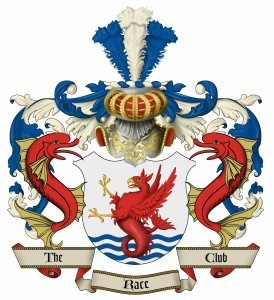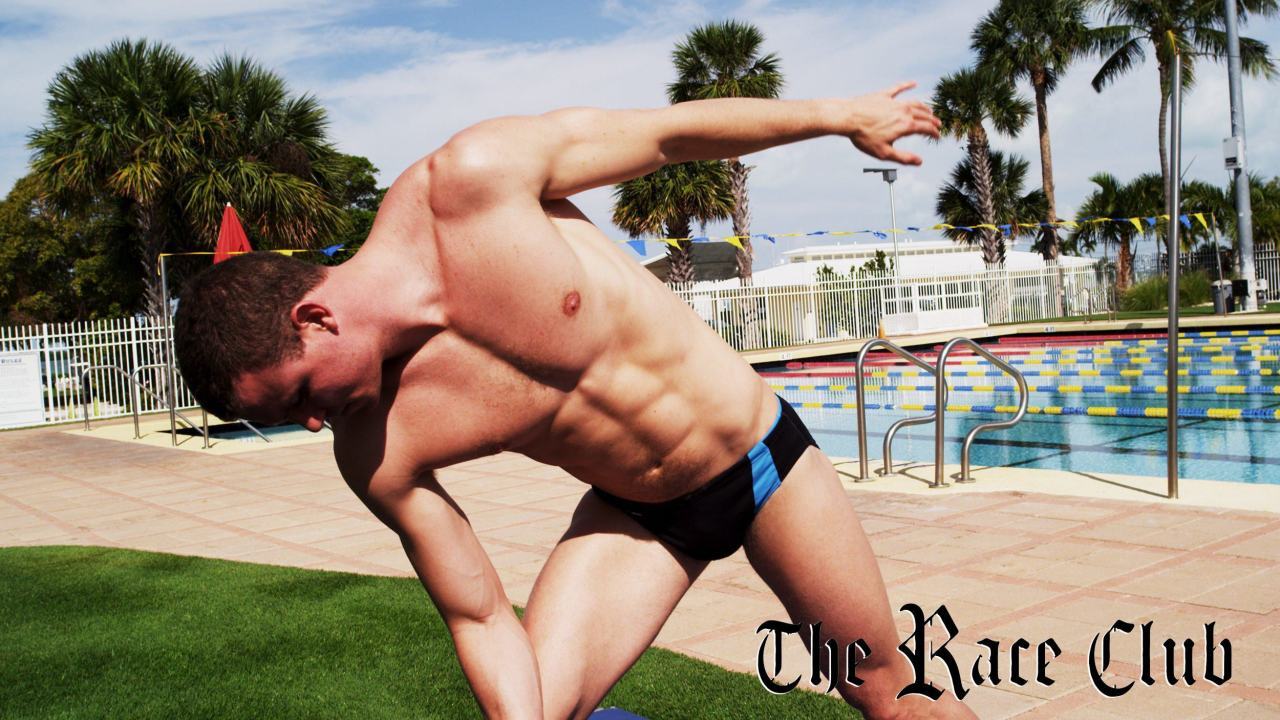Courtesy of Gary Hall Sr., 10-time World Record Holder, 3-time Olympian, 1976 Olympic Games US Flagbearer and The Race Club co-founder.
There are three different facets of dry land training, all of which are important; strength training, stretching and fitness. I am not aware of any elite swimmer that does not incorporate a dry land program into his or her training. It is that important. The following reflects some of our philosophy at The Race Club regarding dry land training for freestylers.
DEVELOPING EXPLOSIVE POWER
When it comes to developing explosive power in the water, which is particularly critical for sprinting, dry land contributes more than swim training. However, because of the exquisite sensitivity to increasing frontal drag with small changes in shape, one has to be extremely careful about developing bulk strength. Swimming is a sport where bigger and stronger does not necessarily make one faster. In fact, we often see the opposite. Consequently, most good strength trainers familiar with our sport have evolved into programs focusing on developing swim-specific strength, building the core muscles involved in the correct swimming motions, while largely ignoring the rest. Becoming strong while remaining lean is a key to fast swimming.
HOW & WHEN TO STRETCH
Most of the elite freestylers of the world also have hyper-mobility of certain joints, most notably the shoulders, elbows, knees and ankles. Even so, there is controversy about stretching; how it should be done, when it should be done and if it should be done. Some of the controversy revolves around the question of whether hyper-mobile joints are more prone to injury. Certainly in contact sports that is true, but most of the injuries in swimming are due to overuse, not blunt trauma, and in such cases, hyper-mobility of the joints is not likely to be a contributor. It may even be a preventative measure for joint-related pain.
WHY FLEXIBILITY MATTERS
When it comes to flexibility, however, I do know this. In a sport where small degrees of angles make huge difference in the amount of propulsion that can be generated or the amount of frontal drag that can be reduced, freestylers must have great flexibility in certain joints. Ankles are a good example. To develop a fast flutter kick, one must have extreme plantar flexibility in order to get the surface area of the top of the foot to push backward on the down kick. Not having it is like trying to be a good gymnast without being able to do the splits. It doesn’t work.
Finally, we use dry land training to develop fitness, particularly with the core muscles and the kick. Throughout a swimming race, the core and leg muscles never stop working. Consequently, they are normally the first parts of the body to give out. To swim fast, much strength and fitness is required of both. If we lose the ability to sustain the tight strength and motion of either legs or core, what follows is not pretty.
Japan has enjoyed great success in swimming in the recent few Olympic Games. One of the reasons, I believe, is that their coaches spend more time on dry land training than we generally do. The result has been stronger, fitter and faster swimmers. Perhaps we need to learn something from them.
I hope you will enjoy watching some of the dry land exercises we use at The Race Club on the #swimisodes below.
http://www.theraceclub.com/videos/swimming-workouts-dryland-stretching-exercises/
http://www.theraceclub.com/videos/dry-land-training/

Gary Hall, Sr., Technical Director and Head Coach of The Race Club (courtesy of TRC)
Yours in swimming,
Gary Sr.
https://www.facebook.com/theraceclub
http://instagram.com/theraceclub
https://twitter.com/theraceclub
https://www.linkedin.com/pub/gary-hall/9/908/671
[email protected] <http://[email protected]
Www.theraceclub.com <http://www.theraceclub.com
THE RACE CLUB
 Because Life is Worth Swimming, our mission is to promote swimming through sport, lifelong enjoyment, and good health benefits. Our objective is for each member of and each participant in The Race Club to improve his or her swimming performances, health, and self-esteem through our educational programs, services and creativity. We strive to help each member of The Race Club overcome challenges and reach his or her individual life goals.
Because Life is Worth Swimming, our mission is to promote swimming through sport, lifelong enjoyment, and good health benefits. Our objective is for each member of and each participant in The Race Club to improve his or her swimming performances, health, and self-esteem through our educational programs, services and creativity. We strive to help each member of The Race Club overcome challenges and reach his or her individual life goals.
The Race Club provides facilities, coaching, training, technical instruction, video, fitness and health programs for swimmers of all ages and abilities. Race Club swim camps are designed and tailored to satisfy each swimmer’s needs, whether one is trying to reach the Olympic Games or simply improve one’s fitness. Our programs are suitable for beginner swimmers, pleasure swimmers, fitness swimmers, USA swimming or YMCA swimmers, or triathletes; anyone who wants to improve swimming skills. All of our Race Club members share an enjoyment of being in the water and use swimming to stimulate a more active mind and body.

I’m an OT athlete. I’ve worked on plantar flexibility for years on end and can still barely point them. Am I screwed?
My daughter is 10 years old and I’m after dry land training exercises for her to improve her over all strength in her swimming. She’s quite a small girl compared to other girls however has a strong core but weaker upper body interns of strength in the pool. Can you help in providing dry land exercises to assist in her overall development. We are from MELBOURNE Australia. Thank you
This workout so much with my swimming and diving thanks to a balanced diet and this workout I’m a 6th grader swimming faster than my high school team
Thanks for your comments. I do look at the kick and pull in a different way than most and refer you to an article that I wrote a while ago, explaining my position:
http://www.theraceclub.com/aqua-notes/swimming-kick-speed-determines-baseline-swim-speed/#more-8669
The truth is that swimmers with poor kicks or two-beat kicks get very little propulsion out of their legs (feet) so the higher proportion of propulsion coming from the legs is more relevant to sprinters or hip-driven or hybrid freestylers. However, the leg propulsion is why they are so fast.
With respect to strength training, I believe the closer we can simulate the motions of the swimmer in doing strength exercises, the more effective they are. If we build… Read more »
Propulsive power in the water is very different than lifting power. It is derived from a number of concurrent motions of arms, legs and body. The motions are fairly rapid and must be sustained for relatively long periods. In freestyle, for example, for most elite swimmers, at least 60-70% of the overall body speed is derived from the kick. For breaststroke and fly, it is even higher. Developing swim-specific strength and fitness is key….along with enough flexibility and timing to make the motions effective.
I’m curious why you say 60-70% of the speed comes from the kick? It’s pretty common for swimmers to be able to pull with pull-buoys close to the same times they can swim (the pull-buoy obviously aids in flotation), while even the most impressive kickers have kicking times that are significantly slower than full swimming. (i.e a beast kicker like Matt Grevers can probably kick a 100 with a board in :52-54ish, but he swims it in 41 and i’d guess he can pull much faster than 52)
To me this suggests that the kick is primarily for body position / flotation and the pull provides a greater percentage of the speed, but perhaps you looked at it in a… Read more »
Hmmmm….I second “swimlifter” here. The only swimmers who’s kick contributes to 70% of their speed have huge feet (or are wearing fins). As far as the butterfly and contrary to what most people think, the “kick” simply acts as a weather vane (mostly),keeping the body in-line to reduce drag. Having a heavy ‘fly kick can lead people to severe back injuries. Don’t believe me? No problem, watch Richard Quick’s “championship butterfly” video, which I used to perfect my ‘fly. There is a never-ending supply of mediocre or downright misinformation on the web, and this is no different.
P
Best way to develop explosive power is through olympic lifting. It is easy enough not to add bulk to swimmers by simply watching reps done. Best lifts to build/achieve explosive power clean, snatch, and jerks.
I sure do love me some olympic lifts
I agree that these are a phenomenal tool for developing explosive power, however it’s very difficult to get the technique down well enough to push the weights and get adequate carryover. Too often these turn into upper back/trap pulls instead of violent leg drive to generate force on the bar.
How often do you guys have your swimmers squat? What about box jumps, (lightly) weighted squat jumps, push press or power jerks? In my somewhat uninformed opinion these exercises could be taken better advantage of to develop power in the shoulders and legs. Additionally, doing them correctly requires a neutral spine and incredibly strong backs/trunks … also important for swimming.
Those exercises obviously can add bulk but that depends on… Read more »
God I hate troughs
I would have liked to see some onsite material, as opposed to being directed off site for content. It’d be fine if there was a ‘for more information’ or something along those lines, but the lack of content does not encourage me to follow the links.